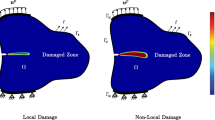Abstract
A self-consistent theory has been developed to account for the variation in fatigue crack growth rates with load ratio,R, without reference to crack closure concepts. The theory states that (a) for an unambiguous description of cyclic damage, two loading parameters are required; (b) consequently, there are two thresholds corresponding to each parameter that must be satisfied for a crack to grow; (c) these two thresholds are intrinsic and are independent of specimen geometry; (d) a fundamental threshold curve can be developed that is independent of test methods defining these two thresholds from the asymptotic values, and last; (e) the two thresholds vary with the degree of slip planarity, microstructure, and environment. Based on these new concepts, we have classified the entire fatigue crack growth behavior into five different classes using the experimental ΔK th -R data. The characteristic feature of each class is discussed, and the supporting examples of materials behavior are provided. This classification could provide a basis for understanding the synergistic effects of mechanical and chemical driving forces and microstructure contributing to fatigue crack growth.
Similar content being viewed by others
References
A.K. Vasudévan, K. Sadananda, and N. Louat:Scripta Metall. Mater., 1992, vol. 27, p. 1673.
A.K. Vasudévan, K. Sadananda, and N. Louat:Scripta Metall. Mater., 1993, vol. 28, p. 65.
A.K. Vasudévan, K. Sadananda, and N. Louat:Scripta Metall. Mater., 1993, vol. 28, p. 837.
A.K. Vasudévan, K. Sadananda, and N. Louat: inFatigue ’93, S.-P. Bailon and J.I. Dickson, eds., Engineering Materials Advisory Services, Warley, United Kingdom, 1993, vol. I, p. 565.
K. Sadananda, N. Louat, and A.K. Vasudévan: inFatigue ’93, J.-P. Bailon and J.I. Dickson eds., Engineering Materials Advisory Services, Warley, United Kingdom, 1993, vol. I, p. 571.
K. Sadananda and A.K. Vasudévan: inAspects of High Temperature Deformation & Fracture in Crystalline Materials, Y. Hosoi, H. Yoshinaga, H. Oikawa, and K. Maruyama, eds., The Japan Institute of Metals, Nagoya, Japan, 1993, p. 551.
N. Louat, K. Sadananda, M. Duesbery, and A.K. Vasudévan:tMetall. Trans. A, 1993, vol. 24A, pp. 2225–32.
K. Sadananda and A.K. Vasudévan: ASTM STP-1220, 1995, in press.
A.K. Vasudévan, K. Sadananda, and N. Louat:Mater. Sci. Eng., 1994, vol. A188, pp. 1–22.
R.A. Schmidt and P.C. Paris: ASTM STP-536, 1973, p. 79.
A.K. Vasudévan, K. Sadananda, and N. Louat: inInnovation & Technology Transfer for Corrosion Control, 11th Int. Corrosion Conf. AIM, Milan, Italy, 1990, vol. 3, p. 3.231.
S. Suresh:Fatigue of Materials, Cambridge University Press, Cambridge, United Kingdom, 1991.
P. Woolin and J.E. King: private communication, 1991.
C.J. Beevers:Fatigue Thresholds, Proc. 1st Int. Conf. on Fatigue Threshold, J. Blacklund, A.F. Blom, and C.J. Beevers, eds., Engineering Materials Advisory Services, Warley, United Kingdom, 1982, vol. I, p. 257.
A.T. Stewart:Eng. Fract. Mech., 1980, vol. 13, p. 463.
J. Petit and J.L. Mailard:Scripta Metall., 1980, vol. 14, p. 163.
H. Doker and M. Peters:Fatigue Thresholds, Proc. 2nd Int. Conf. on Fatigue Threshold, C.J. Beevers, ed., Engineering Materials Advisory Services, Warley, United Kingdom, 1984, p. 275.
K. Tanaka: ASTM STP-1020, 1989, p. 151.
C. Masuda, H. Sumiyoshi, M. Kosuge, A. Ohta, and S. Nishijima:Int. J. Fatigue, 1987, vol. 9, p. 223.
M.C. Lafarie-Frenot and C. Gasc:Fatigue Eng. Mater. Structs., 1983, vol. 6, p. 329.
J. Petit, P. Renaud, and P. Violan:Proc. ECF-4 on Fracture, K.L. Maurer and F.E. Matzer, eds., Engineering Materials Advisory Services, Warley, United Kingdom, 1982, vol. 2, p. 426.
B.R. Kirby and C.J. Beevers:Fatigue Eng. Mater. Structs., 1979, vol. 1, p. 203.
S. Suresh, A.K. Vasudevan, and P.E. Bretz:Metall. Trans. A, 1984, vol. 15A, pp. 369–79.
H. Kemper, B. Weiss, and R. Stickler:Eng. Fract. Mech., 1989, vol. 32, p. 591.
R.J. Cook, P.E. Irving, G.S. Booth, and C.J. Beevers:Eng. Fract. Mech., 1975, vol. 7, p. 69.
K. Jerram and E.K. Priddle:J. Mech. Eng. Sci., 1973, vol. 15, p. 271.
J. Mautz and V. Weiss: ASTM STP-601, 1976, p. 154.
E.K. Priddle:Scripta Metall., 1978, vol. 12, p. 49.
R.J. Cooke and C.J. Beevers:Mater. Sci. Eng., 1974, vol. 13, p. 201.
N.E. Frost:J. Iron Steel Inst., 1967, vol. 205, p. 206.
S. Suresh, G.F. Zaminski, and R.O. Ritchie:Metall. Trans. A, 1981, vol. 12A, pp. 1435–43.
J. Denk, O.E. Lepik, and G. Ebi: inFatigue ’93, J.-P. Bailon and J.I. Dickson, eds., Engineering Materials Advisory Services, Warley, United Kingdom, 1993, vol. 3, p. 1797.
J.A. Todd, L. Chen, E.Y. Yankov, and H. Tao:J. Offshore Mechanics and Arctic Eng., Trans. ASME, 1993, vol. 115, p. 154.
A. Ueno, H. Kishimoto, H. Kawamoto, and M. Asakura:Eng. Fract. Mech., 1991, vol. 40, p. 913.
L. Priutt: Ph.D. Thesis, Brown University, Providence, RI, 1993.
N.J. Mills and N. Walker:Polymer, 1976, vol. 17, p. 335.
W. Mai and J.G. Williams:J. Mater. Sci., 1979, vol. 14, p. 1933.
S. Arad, J.C. Radon, and L.E. Culver:J. Mech. Eng. Sci., 1971, vol. 13, p. 75.
L. Pruitt, A.K. Vasudévan, and K. Sadananda: 1995, in preparation.
Author information
Authors and Affiliations
Rights and permissions
About this article
Cite this article
Vasudévan, A.K., Sadananda, K. Classification of fatigue crack growth behavior. Metall Mater Trans A 26, 1221–1234 (1995). https://doi.org/10.1007/BF02670617
Received:
Issue Date:
DOI: https://doi.org/10.1007/BF02670617




